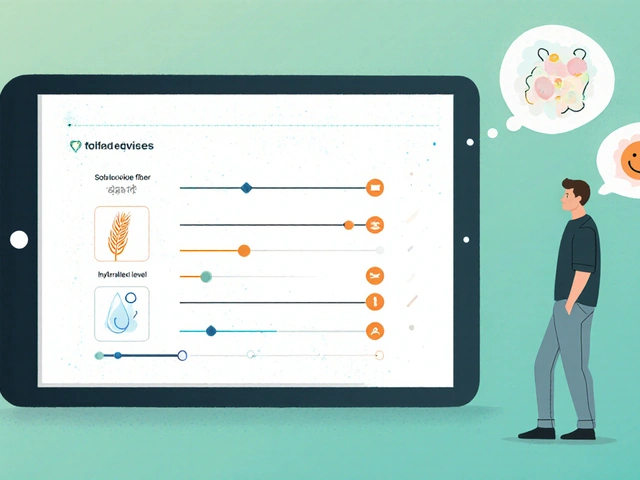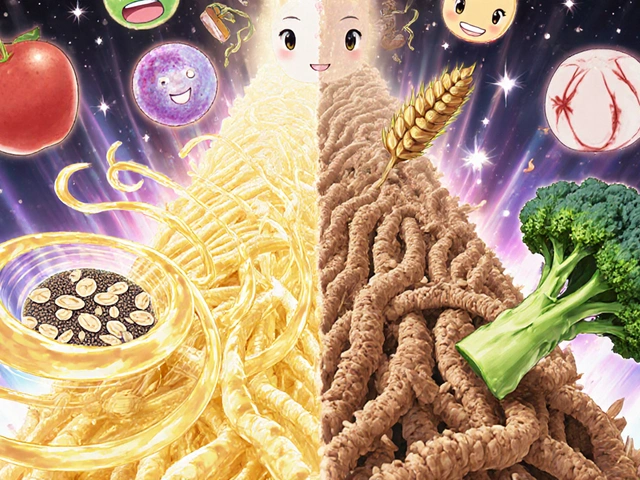Most people know fiber is good for digestion, but few understand soluble and insoluble fiber aren’t just two types of the same thing-they do completely different jobs in your gut. If you’re struggling with bloating, constipation, or blood sugar spikes, the problem might not be that you’re not eating enough fiber. It could be that you’re eating the wrong kind.
What soluble fiber actually does in your gut
Soluble fiber doesn’t just pass through your system. It turns into a thick, gel-like substance when it hits water. Think of it like oatmeal soaking up milk-except inside your intestines. This gel slows down how fast food moves through your digestive tract. That’s why eating oats or beans helps keep your blood sugar steady after meals. Studies show soluble fiber can cut post-meal glucose spikes by 20-30%. That’s not a small thing. For people with prediabetes or type 2 diabetes, that’s the difference between a rollercoaster and a smooth ride.But here’s the real magic: your gut bacteria eat soluble fiber. They ferment it into short-chain fatty acids-mainly butyrate, acetate, and propionate. These aren’t just byproducts. Butyrate is the main fuel for the cells lining your colon. It keeps them healthy, reduces inflammation, and even helps repair damage. A 2024 review in PMC found that soluble fiber directly boosts the good bacteria that make these acids. That’s why people with IBS often feel better when they eat more oats, chia seeds, or apples. The gel also helps regulate stool consistency, so it can ease both diarrhea and constipation.
What insoluble fiber actually does in your gut
Insoluble fiber doesn’t dissolve. It doesn’t turn into gel. It’s like a sponge that soaks up water and adds bulk. Think wheat bran, apple skins, or the outer layer of nuts. It moves through your system mostly unchanged, pushing waste along faster. That’s why it’s so effective for constipation. Research shows it can reduce transit time by 24-48 hours and cut constipation risk by 30-50%.But it’s not just about speed. Insoluble fiber helps prevent diverticulosis-the tiny pouches that form in the colon wall. Long-term studies show people who eat more insoluble fiber have a 40% lower risk of developing them. That’s huge. And it’s not just about bowel movements. Whole grains and vegetables rich in insoluble fiber are packed with other nutrients that work together to protect your gut lining and reduce inflammation.
But here’s the catch: if you have Crohn’s disease or ulcerative colitis during a flare-up, insoluble fiber can make things worse. The rough texture irritates already inflamed tissue. That’s why doctors often recommend low-residue diets during flare-ups-limiting nuts, seeds, skins, and whole grains until things calm down.
Why you need both
You don’t choose one over the other. You need both. Soluble fiber calms your gut and feeds your microbiome. Insoluble fiber keeps things moving. Together, they create balance.The Mediterranean Diet gets it right. It doesn’t focus on fiber supplements or isolated powders. It’s full of whole foods: legumes, vegetables, fruits, nuts, seeds, and whole grains. That mix naturally gives you a 3:1 ratio of insoluble to soluble fiber. That’s the sweet spot. Most people eat too much of one and not enough of the other. If you’re only eating bran cereal and skipping beans, you’re missing the gel-forming benefits. If you’re only eating apples and chia seeds and ignoring whole wheat bread or broccoli stems, you’re not getting the bulk you need to prevent constipation.

Real food vs. supplements
The fiber supplement market is worth over $3 billion. But here’s the truth: pills and powders can’t replicate what whole foods do. A 2024 review found that isolated fibers-like inulin or psyllium husk-don’t deliver the same benefits as fiber from actual plants. Why? Because food isn’t just fiber. It’s also polyphenols, antioxidants, vitamins, and minerals that work together. A chia seed isn’t just soluble fiber. It’s also omega-3s and magnesium. An apple isn’t just pectin. It’s quercetin and vitamin C.Supplements can help in the short term-like psyllium for acute constipation-but they’re not a long-term fix. And they can cause bloating if you don’t drink enough water. That’s why experts say: get fiber from food first. Supplements are backup, not replacement.
How much do you really need?
The official recommendation is 25 grams a day for women and 38 for men under 50. But here’s the problem: the average American eats only 15 grams. That’s less than half. And it’s not just an American issue. Most people worldwide fall short.The key isn’t to suddenly double your intake. That’s how bloating starts. Instead, add 5 grams per week. Start by swapping white bread for whole grain. Add a serving of beans to your salad. Snack on an apple with the skin on. Include chia seeds in your yogurt. Over 4-6 weeks, you’ll hit your target without the gas.
And don’t forget water. For every 25 grams of fiber, drink at least 1.5 to 2 liters of water. Fiber soaks it up. Without enough fluid, it turns into a brick instead of a smooth passage.
What to eat for each type
- Soluble fiber sources: Oats (1-2g per 100g), lentils (2-3g per 100g), beans (5-8g per 100g), chia seeds (5.6g per 30g), apples (1.4g per medium), carrots (0.7g per medium), psyllium husk (7g per tablespoon).
- Insoluble fiber sources: Whole-wheat flour (7.9g per 100g), wheat bran (12g per 100g), nuts (2-4g per 30g), seeds (3-5g per 30g), kiwi (2.5g per fruit with skin), broccoli stems, potato skins, brown rice.
Try this simple daily plan: breakfast with oats and chia, lunch with lentil soup and a side of broccoli, snack on an apple and almonds, dinner with brown rice and roasted carrots. That’s easily 30+ grams of fiber without supplements.

Special cases: IBS, IBD, and diabetes
If you have IBS, soluble fiber is your friend. Oats, psyllium, and bananas often bring relief. Many people notice improvement within two weeks. But avoid raw cabbage, onions, and garlic-they’re high in FODMAPs, which can trigger symptoms.If you have IBD during a flare-up, cut back on insoluble fiber. Skip nuts, seeds, and whole grains. Stick to peeled vegetables, white rice, and cooked fruits. Once symptoms ease, slowly reintroduce insoluble fiber. The goal is 25-30g total fiber daily, but only when your gut is stable.
For diabetes, soluble fiber is a game-changer. It slows sugar absorption, reducing spikes by 15-20%. Pairing beans or oats with carbs makes a big difference. Insoluble fiber helps too-it improves insulin sensitivity by 10-15%. So don’t ignore whole grains.
The gut-brain connection
What you eat doesn’t just affect your bowels. It affects your mood. The short-chain fatty acids from soluble fiber fermentation trigger the release of hormones like GLP-1 and peptide YY. These tell your brain you’re full. They also reduce inflammation linked to anxiety and depression.A 2023 study in the Wise Mind Nutrition blog tracked people who ate beans or soaked chia seeds daily for eight weeks. Seventy-eight percent reported better mood and less brain fog. That’s not coincidence. Your gut and brain talk through the vagus nerve. Fiber is one of the strongest signals in that conversation.
What’s next for fiber science
Scientists are starting to personalize fiber advice. Companies like Viome and Zoe now test your gut bacteria to see how you respond to different fibers. Some people produce more butyrate from oats. Others respond better to legumes. In the next five years, your doctor might give you a fiber plan based on your microbiome-not just your age or gender.But you don’t need a test to start. Right now, you can do something simple: eat more plants. Mix your fiber. Drink your water. Go slow. Your gut will thank you.
Can soluble fiber help with diarrhea?
Yes. Soluble fiber forms a gel that thickens loose stools. Foods like oats, bananas, and psyllium husk are often recommended for diarrhea, including in IBS. It doesn’t stop the cause, but it regulates consistency and reduces urgency.
Is insoluble fiber bad for IBD?
During a flare-up of Crohn’s or ulcerative colitis, insoluble fiber can irritate inflamed tissue and worsen symptoms like cramping and diarrhea. It’s best to limit nuts, seeds, skins, and whole grains until symptoms improve. Once stable, slowly reintroduce them to build tolerance.
How quickly will I see results from eating more fiber?
For constipation, you might notice changes in 3-7 days. For blood sugar control or gut microbiome shifts, it takes 2-4 weeks. Mood improvements linked to fiber fermentation can take 6-8 weeks. The key is consistency-not sudden spikes.
Can fiber supplements replace whole foods?
No. Supplements like psyllium or inulin can help in specific cases, but they lack the vitamins, antioxidants, and phytonutrients found in whole foods. A 2024 review confirmed isolated fibers don’t replicate the full benefits of plant-based fiber. Use supplements as a temporary tool, not a daily replacement.
Why does fiber make me bloated?
Bloating usually happens when you increase fiber too fast or don’t drink enough water. Your gut bacteria need time to adjust. Start with 5 extra grams per week and drink 1.5-2 liters of water daily for every 25g of fiber. If bloating continues, try soluble fiber first-it’s gentler than insoluble.



Jacob McConaghy
November 24, 2025 AT 11:43I used to think fiber was just about avoiding constipation, until I started eating oats and chia every morning. My bloating vanished, and my blood sugar stopped crashing after lunch. No more 3 p.m. energy zombie mode. I didn’t even need supplements-just real food. Seriously, try swapping white toast for oatmeal one week. Your gut will throw you a party.
Natashia Luu
November 25, 2025 AT 16:57This article is dangerously oversimplified. Fiber is not a magic bullet. The notion that soluble fiber 'feeds good bacteria' is reductionist pseudoscience. The microbiome is not a petri dish. To suggest that chia seeds or oats can 'regulate' complex gastrointestinal conditions is irresponsible. Many patients are harmed by misguided dietary advice. Professional medical guidance is non-negotiable.
akhilesh jha
November 26, 2025 AT 13:07Very interesting. In India, we’ve always eaten dal and roti together-never thought about it as soluble and insoluble fiber. But now I see: dal is soluble, roti crust is insoluble. My grandma never knew the science, but she knew how to feed a gut. Maybe tradition had it right all along. I’m going to start adding more banana peels to my smoothie-heard they’re full of fiber. Is that safe?
Jeff Hicken
November 27, 2025 AT 10:23lol i read this whole thing and now i feel dumb. i thought fiber was just bran cereal and prunes. turns out i’ve been eating like a caveman who hates his colon. psyllium husk? chia? broccoli stems?? i thought those were just garnishes. also i drank 2 liters of water once in 2021 so… yeah. my gut is probably judging me right now. 😅
Vineeta Puri
November 28, 2025 AT 16:26While the article presents compelling evidence, it is imperative to acknowledge that individual physiological responses to dietary fiber vary significantly. For individuals with pre-existing gastrointestinal pathologies, a one-size-fits-all approach is contraindicated. The recommendation to gradually increase intake is scientifically sound; however, the absence of explicit guidance regarding professional dietary consultation is a notable omission. Nutritional interventions should be personalized and monitored.
Victoria Stanley
November 29, 2025 AT 04:40Love this breakdown! I’m a nurse and I’ve seen so many patients with IBS who panic when they hear ‘fiber’-they think it’s all bran and raw veggies. But once they try soaked chia in yogurt or mashed lentils, their symptoms improve. The key is starting slow and focusing on soluble first. Also, water is non-negotiable. I tell my patients: if your pee looks like apple juice, you’re not drinking enough. 😊
Andy Louis-Charles
November 29, 2025 AT 09:30Just tried the 30g/day plan: oatmeal + chia + apple + lentil soup + almonds + brown rice. Felt like a superhero by dinner. No bloating, no crashes. Also, my poop? Perfect. 🙌 I used to think fiber was for hippies and health nuts. Turns out it’s just… biology. And I’m now a believer. Thanks for the clarity!
Douglas cardoza
November 30, 2025 AT 12:15My mom used to say ‘eat your veggies, they’re good for you’ and I rolled my eyes. Now I’m 38, eating lentils like they’re candy, and my gut’s never been happier. No magic pills. Just food. Who knew?